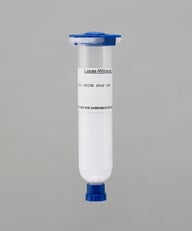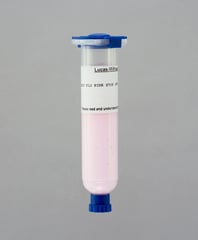How Stop-Off Works
To understanding how Stop-Off works, let's review the brazing process. At Lucas Milhaupt, we preach six fundamentals of brazing:
1. Good fit & clearance
2. Clean metals
3. Uniform fluxing
4. Proper assembly
5. Brazing technique
6. Post-braze cleaning
Let's focus on Step 2 - cleaning metals, and Step 3 - fluxing parts. Lucas-Milhaupt recommends that you clean parts of any cutting oils, dirt, and residual oxides prior to brazing. The braze alloy will not flow properly over areas that are not cleaned, and the quality of the brazed joint will be compromised. The role of flux and/or atmosphere in the brazing process is to remove oxides that bonded to the surface of the base metals during the heating process, and to prevent any further oxidation of the braze joint area once the flux has activated. (Remember that braze alloy will not flow onto surfaces that do not have oxides removed at the brazing temperature.)
Stop-Off consists of a selective oxide powder in a binder system. The binder holds the oxide powder to the surface of the base metal.
Stop-Off is usually made from reactive base metal oxides including alumina,  titanium oxide, and zirconium oxide. Most fluxes and atmospheres are unable to remove these oxides using standard brazing practices, especially not in high concentrations. Because the flux and/or atmosphere is unable to remove these oxides, the braze alloy is not able to adhere to the region where the Stop-Off was applied.
titanium oxide, and zirconium oxide. Most fluxes and atmospheres are unable to remove these oxides using standard brazing practices, especially not in high concentrations. Because the flux and/or atmosphere is unable to remove these oxides, the braze alloy is not able to adhere to the region where the Stop-Off was applied.
Therefore, Stop-Off is useful in applications where the flow of braze alloy must be contained or redirected, due to aesthetics, tolerances, and even subsequent assembly steps. Examples include assemblies with threads and holes.
Forms of Stop-Off
There are various forms of Stop-Off which combine different metal oxides and binders. Most of these are naturally white in color, so suppliers add unique colors as a means of differentiating among their products  and also distinguishing them from competitors' products. These colors do not affect the performance of the products.
and also distinguishing them from competitors' products. These colors do not affect the performance of the products.
However, different binder systems do give the products unique characteristics. For example, binders may be formulated to hold the Stop-Off in place, dispense it uniformly, wash off easily, or provide other such features. Stop-Off products can be applied by brush, roller, or squeeze bottle. Always choose your Stop-Off product to match your production environment.
Stop-Off products from Lucas Milhaupt are formulated to stay where they are initially placed; making them ideal for preventing alloy from flowing into precise designs involving threads, holes, or other intricate designs.
Lucas-Milhaupt 460 Stop-Off is specially formulated for best adhesion to base metals. Applications may include dip brazing, induction, resistance applications, and flame brazing with high-velocity torches.
Lucas-Milhaupt 470 Stop-Off is specially formulated for furnace- and vacuum-furnace brazing. It can be used in torch, furnace, induction, and resistance brazing. A key benefit is minimization of post-braze cleaning, as 470 is reduced to a powder which is easily removed.
Conclusion
Because of aesthetics, tolerances, or subsequent assembly steps, you sometimes need the flow of braze alloy to be contained or redirected-to STOP flowing or to stay OFF a surface. Examples include precise designs involving threads or holes. For these situations, Lucas-Milhaupt Stop-Off products will provide the needed solution, with a variety of metal oxides and binders available for your application.
Questions? We are pleased to provide more information on brazing procedures. See our website for information on Lucas-Milhaupt products or services, or contact us for further assistance

